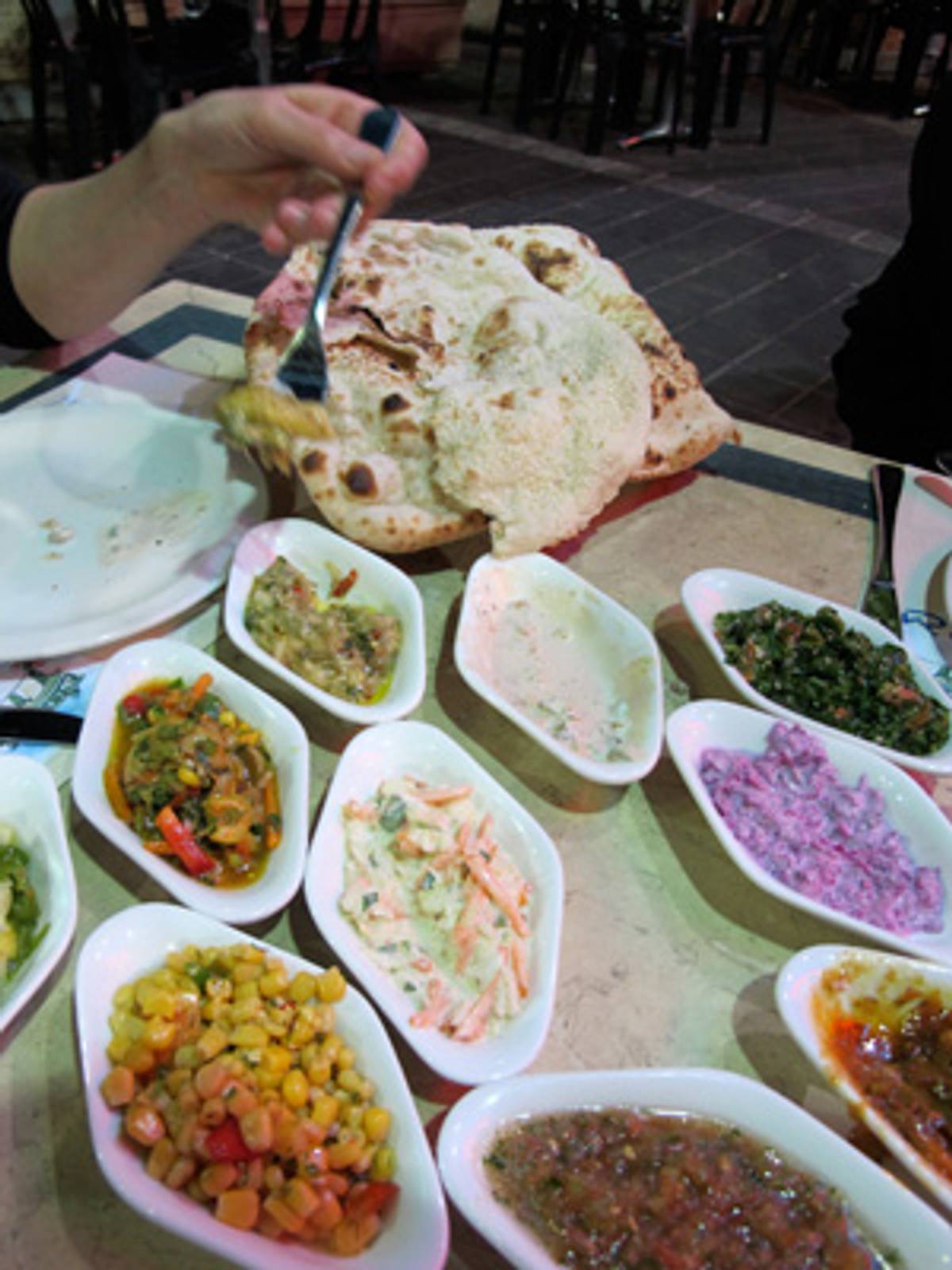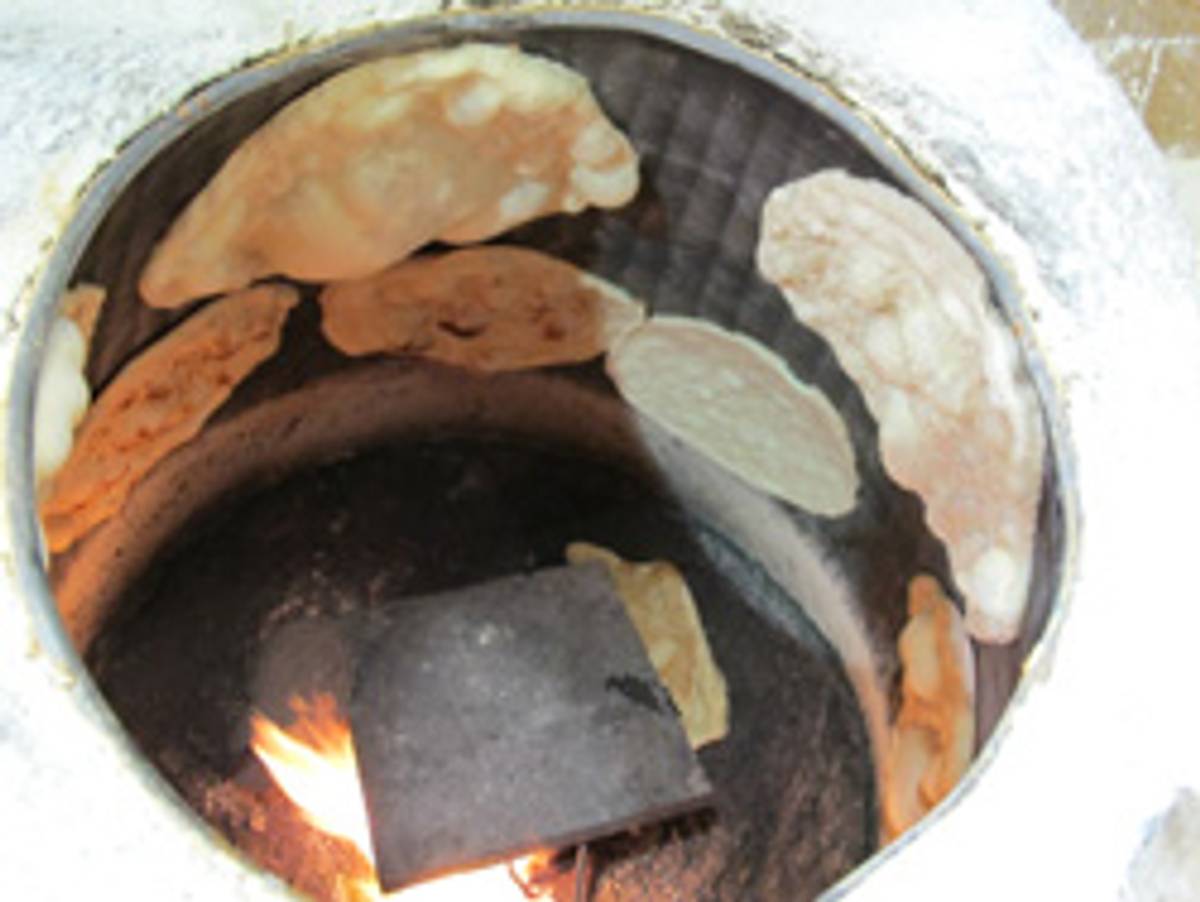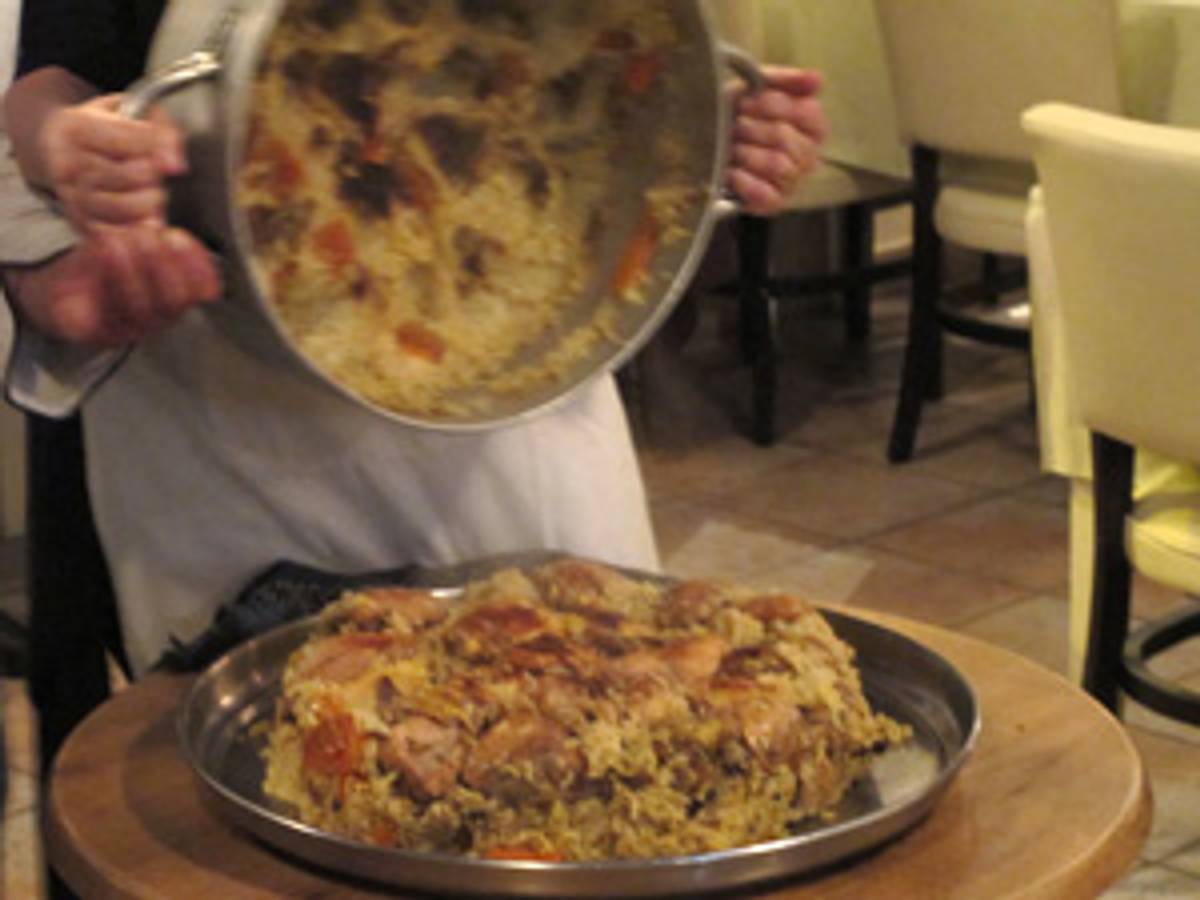Stations of the Fork
A tour of restaurants in the Holy Land




Last month, just before Passover, I escorted six journalists on a culinary quest through Israel. For six days, we met with food writers, chefs, and ordinary people, touring colorful markets overflowing with fresh spices and pomegranates so ripe you wanted to bite into them, asking the question: Is there a genuine Israeli cuisine? Israeli cooking revolves around dietary laws and the native foods of the Middle East. It’s also touched by the globalism of this polyglot country. Israel’s cuisine is in transition and has three iterations: everyday food, traditional food served on the Sabbath and holidays, and what I call dress-up food, which is found in restaurants and on chefs’ TV shows, expanding continuously with the introduction of items from all over the world. It is mostly humble food, often prepared imaginatively, brusquely, with what one chef called “Israel’s brazenness.”
Israel’s restaurant scene has changed dramatically in the past 20 years, as is evidenced by the large number of high-caliber eateries run by thirtysomething chefs. When I lived in Israel in the 1970s, it was almost blasphemous to think about food as a pleasure; it was merely sustenance, and the only kinds of restaurants anyone but tourists could afford were cafés and falafel and hummus joints. “Years ago, it was kind of a shame to eat good food in Israel,” said Israel Aharoni, 59, a chef with a single black braid down his back and an eponymous popular television show. “Immigrants had just come here with hardly anything on and were struggling for their survival,” he continued. “When my generation started traveling after military service, we saw the rest of the world was having fun. We saw that food was not just for fueling your body. Revolutions come from young people. Slowly, slowly it happened in Israel.”
Our group started in Tel Aviv, a city fueled by creativity in high tech and the arts, and lately, in cuisine. Our first stop was at Cordelia’s (Yefet 30, Jaffa, 03-5184668) nestled down an arched alley near the clock tower in Jaffa. Run by chef-owner Nir Zook, 33, this restaurant sits in a 1,000-year-old stone crusader house and has an artsy atmosphere thanks to mismatched candelabras and chandeliers, which reflected light down the long table at which we ate a Sabbath dinner. With goat cheese fresh from Zook’s brothers’ farm in Emek Ha-Ela, the valley where David slew Goliath, and wine from Tzora and other local vintners, the unusual meal combined recipes for gefilte fish and chicken soup with matzo balls that Zook gleaned from his mother with his own specialty of a grape-leaf-and-garlic dip, made with newly plucked leaves, that resulted in a fabulous Middle Eastern spicy pesto.
The next evening, I wanted to find a shipudia, a simple grilled skewered meat place. Our cab driver suggested we go to Haj Kahil (Yefet 93, Jaffa, 03-6581211), an Israeli-Arab restaurant in Jaffa. As we approached the entrance, with a sign in Hebrew, Arabic, and English, we saw groups of Jews and Arabs sitting outside on the patio. I asked the Arab manager about the mezuzah on the door. It was there for Jewish customers who touch it for good luck, he told me. We ordered a colorful array of mezze—one I especially liked was boiled and grilled cauliflower covered by a tahina sauce. As good as it was, the prize there was the laffa, the thin flat bread slapped to the sides of the taboon (a clay, cone-shaped, wood-burning oven) as well as the grilled pieces of fresh foie gras, somewhat unusual in a spot better known for its lamb skewers. The foie gras we ate that night came from Hungary, as Israel, once the world’s fourth-largest foie gras producer, banned its production in 2003.

We continued the next day at Catit (Hayachol Hatalmud 4, Tel Aviv, 03-5107001), where Meir Adoni, 38, a young man of Moroccan descent, runs the kitchen. We ate a tasting menu including an over-the-top decomposed Caesar salad and sweetbreads with honey, garlic, vichyssoise, asparagus, and parsley foam. Located in a house built in 1911 in a fine residential neighborhood with a beautiful terrace in the back, the restaurant’s minimal décor is all white. I had brought Adoni to Worlds of Flavors festival in Napa Valley two years ago, where I saw his great potential as a cook. He told me then that his restaurant started out in his moshav, or cooperative village. As he traveled around the world, soaking in the techniques of other chefs, his reputation grew, and he eventually moved his restaurant to Tel Aviv, where he creatively infuses his food with flavor and exotic touches. Yet for a jaded journalist like me, the simplest food, like a slivered green almond placed in a grilled eggplant salad, appealed the most.
In contrast to the formality at Catit, our next meal was a casual one of tapas at Herbert Samuel (Koifman 6, Tel Aviv, 03-516 6516), just a short walk from the seashore. Although I have never met Jonathan Roshfeld, the talented chef of this restaurant, I adore his food. It has a fresh, slightly wild Israeli feel to it, evident in the way he presents his sauces with a brush of the spatula and the way he arranges the local sun-soaked vegetables. The salads were especially mouth-watering and full of colorful, plump, sweet, fresh-from-the-market ingredients plated with a broad swath of sauce. One in particular—a tomato salad with hard-boiled eggs, micro-greens, and olives—was the best I have ever tasted. Israeli engineering and the hot sun on the tomato plant paid off.
Later we hit Raphaël (Hayarkon 87, 03-5226464), adjacent to the Dan Hotel. I have been following its chef, Rafi Cohen, since I met him 10 years ago when, at 24, he worked at La Regence Restaurant in Jerusalem’s King David Hotel. He started there as an apprentice, at 13, having quit school. Now 34, Cohen has hit his stride, offering high-end continental cuisine with a Mediterranean twist and further embellishing his Moroccan dishes, like couscous and brik, a crisp pastry used in thin cigar-like appetizers filled with simple meat and onions, tomatoes, peppers, or whatever is in season. He comes by the North African inflection honestly; his family is from Morocco, and his uncle, who travels every day to Tel Aviv from Jerusalem, prepares the couscous and brik for the restaurant using the same techniques Cohen’s grandmother used. This restaurant shows what I saw all over Israel—that young chefs are both enhancing their family recipes and fusing local foods with ingredients and ideas from all over the world.

Our next stop was a Bedouin home outside Nazareth. I have been to many ethnic home restaurants throughout Israel—you eat a meal with a Kurdish, Syrian, or any other type of family and have the opportunity to learn about traditional food. This meal was a sumptuous array of eggplant, zucchini, and tabouleh salads, followed by a roasted lamb so tender you wanted to pick it apart with your fingers. and frika, the green wheat, or spelt, mentioned in the Bible and charred by Ruth. I found it as a smoky treat on menus throughout Israel.
In the village of Matat, in the Upper Galilee, we visited Erez Komarovsky, 47, who runs a cooking school out of his home near the Lebanese border. After years of working in bakeries all over the United States and France, Erez Komarovsky returned to Israel and started the successful bakery Lehem Erez, which has branches all over the country. A few years ago he sold the business and now works as a consultant and teacher. We watched as he gathered wild asparagus and picked Jerusalem sage, vine leaves, and cyclamen for stuffing with rice and meat. Ever the locavore, he also cooked frika instead of bulgur. “Israeli cuisine is intuitive, it comes from the belly,” he said, as he cooked the frika with scallions and parsley. “It is faster cuisine and represents the national character and is a little arrogant, as we are.” Erez Komarovsky crushed fresh coriander seeds with a mortar and pestle to add to the dish and mixed the mash with Syrian olive oil. A carpaccio of goat, sliced ever so thinly, was served with grilled eggplant, both simple and fresh, as was a seared piece of goat first coated with an herb mixture served with a hummus made out of lima beans.

Jerusalem was saved for last. On our first morning there we scavenged for food with chef Moshe Basson, picking sage and other native herbs near the Old City. At one point, Basson pulled out a bottle of champagne and some Iraqi turnovers filled with wild spinach prepared by his mother. That night at Eucalyptus (Artist Colony of Hutzot Hayotzer, Jerusalem, 02-6244331), just outside the Old City, we started our meal with a cocktail of arrack and grapefruit juice. Then Basson prepared the herbs in what he calls Canaanite cuisine, the cuisine of early Israel. He made favorites like his signature Jerusalem artichoke soup and stuffed figs with chicken. Then, with fanfare, he tapped and flipped the bottom of a pan to reveal makluba, a rice and chicken dish that he learned from Palestinian chefs, who partner with him in the nonprofit organization Chefs for Peace.
In the Old City, we sampled a delicate pastry filled with sheep’s cheese at Zalatimo’s, a bakery near the Church of the Holy Sepulchre. The present owner and member of the Zalatimo family prepares this confection as his family has for more than a century, twisting the dough, filling it with the cheese, baking it, and then coating it with a sugar syrup. After that we walked to Lina’s (Shchunat Hanotzrim, just inside Damascus Gate, Jerusalem, 02-6277230), one of the ubiquitous hummus places in the Old and New City. Purist hummus—lacking any traces of cumin or garlic—it was just warm pureed chickpeas with toppings including pine nuts and fava beans.
We strolled through Mahane Yehudah, the Jewish shuk, sampling falafel, and then we ate at Morduch (Agripas 70, Jerusalem, 02-6245169), a tiny Kurdish restaurant where customers point at the dishes they want. I was so happy that it was as I remembered, offering seasonal vegetables stuffed with meat and rice, fried kubbe made with bulgur and meat, and the Sabbath kubbe soup. It has a chicken broth with lemon, dried limes, herbs, and celery—a recipe so old it is considered Aramaen. Plump dumplings made out of semolina dough and bulgur and filled with meat and pine nuts float in the broth.
Our last stop was at Mahane Yuda (10 Bet Yaakov, Jerusalem, 02-5333442), also in the shuk, a trendy spot owned by three friends and filled with chairs and tables scavenged from their families. Thirteen chefs work in the kitchen, which is run like a kibbutz. I was blown away by the inventiveness there: oxtail soup over cracked wheat with dried wild berries and walnuts, black risotto with mussels and shrimp, meatballs, beef spareribs marinated in balsamic vinegar served with polenta. The private-labeled Berta wine was named after one of the owner’s grandmother. This restaurant has captured the hearts of the next generation of Israelis who want to dine with lots of noise. Hopefully it’s a hint of where Israeli food is going.
Joan Nathan is Tablet Magazine’s food columnist and the author of 10 cookbooks including King Solomon’s Table: a Culinary Exploration of Jewish Cooking from Around the World.